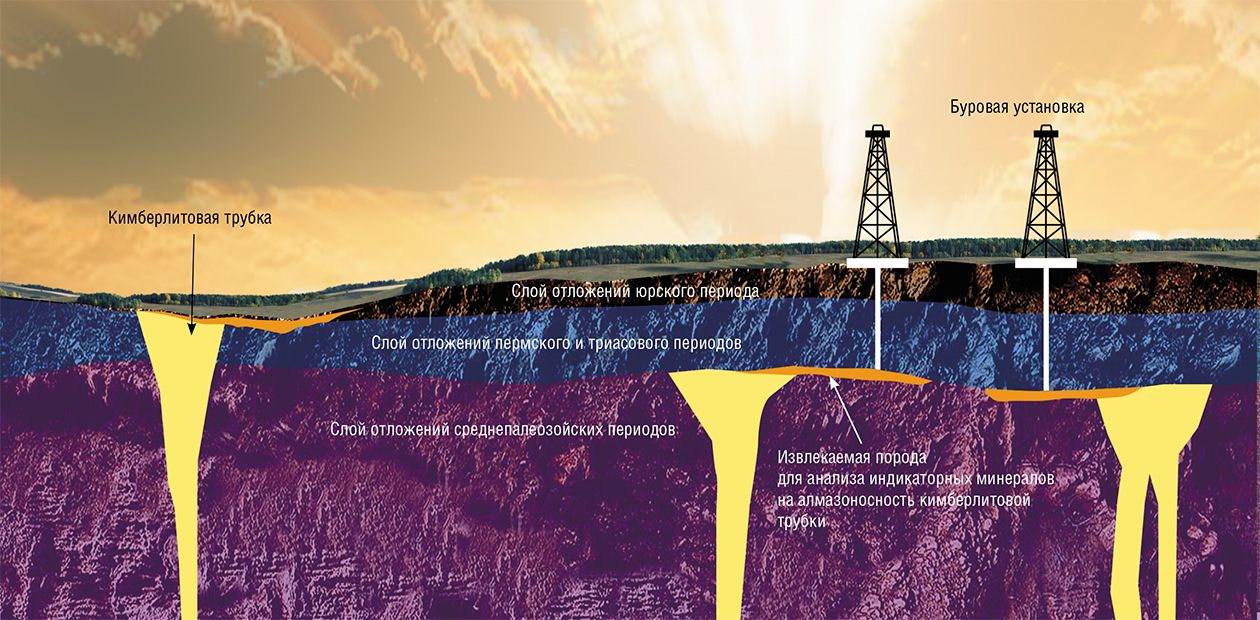Diamond Deposits for Russia
This summer, the first eight scientific expeditions went to the north of Yakutia within the framework of a federal project on the evaluation of diamond resources yet to be discovered on the Siberian platform. For the first time in the contemporary history of Russia, the manager of a large federal project is an academic body – the Sobolev Institute of Geology and Mineralogy of the Siberian Branch of the Russian Academy of Sciences (IGM SB RAS). This has become possible thanks to the Institute’s long and successful experience in the development and practical application of reliable methods for diamond deposit prognosis and prospecting
Studies of diamond deposits on the Siberian platform were initiated by the distinguished petrologist and mineralogist V. S. Sobolev, Academician and author of the famous prognosis on the discovery of diamonds in Yakutia. Having moved to Novosibirsk in a very early stage of the organization of the Siberian Branch of the USSR Academy of Sciences, he immediately founded and took charge of the investigation program on the petrology and mineralogy of kimberlites and of the upper mantle, launched at the Institute of Geology and Geophysics, and focused in particular on diamond formation in nature.
The scientists made a crucial effort to elucidate the composition and structure of the upper mantle of the Siberian platform as well as to find out the characteristic features of the environment favoring the growth of natural diamonds. Special attention was paid to searching for the reliable criteria for the determination of diamond content in kimberlites. This task was particularly important since among hundreds of kimberlite bodies discovered in the 1950s and 1960s only 10 % possessed an elevated diamond content and just 3—4 % were commercial.
A solution to this problem was suggested by the diamonds themselves or, more precisely, by mineral inclusions inside them. As far back as in the late 1960s, the future Academician N. V. Sobolev and his co-authors published the results of the studies on the composition of the pyrope garnets included in Yakutian diamonds. Their composition turned out to be markedly different from that of common pyropes embayed in kimberlites. In particular, the concentration of chromium was much higher and the concentration of calcium was much lower.
The well-known American scientists F. R. Boyd and H. Meyer explained these specific features of garnet composition by pyrope crystallization in the very early and deep stages of kimberlite melt evolution. According to their hypothesis, diamonds growing in the same melt trapped pyropes of an unusual composition. In this way, they proved to be isolated from the evolving kimberlite melt and did not change their composition.
In the late 1960s, in the xenoliths of diamond-bearing pyropic serpentinites from the Aykhal pipe, for the first time pyropes of a similar composition were found outside diamonds (Sobolev et al., 1969).
Comparative analysis of the characteristic features of the composition of pyropes enclosed in diamonds and those enclosed in the xenoliths of diamond-bearing serpentinites allowed N. V. Sobolev to propose a fundamentally different hypothesis. He suggested that the above-mentioned compositional features of pyropes associated with natural diamonds were connected with the nature of their mineral paragenesis. Another important mineral involved in this paragenesis was chromite. Its inclusions were also found in the diamonds and xenoliths of diamond-bearing serpentinites and had very high concentrations of chromium and abnormally low content of titanium.
Based on this model, N. V. Sobolev supposed that findings of pyropes and chromites of a similar composition in the kimberlite concentrates or in the minerals of the heavy fraction of kimberlite dispersion haloes could serve as a criterion for the evaluation of their potential diamond content.
To verify this hypothesis, in the early 1970s, scientists of the Institute received and thoroughly studied samples from 28 Yakutian kimberlite pipes, the diamond content of which ranged from zero to the highest values. Statistical analysis of the results obtained showed a strong correlation dependence of diamond content on the presence of pyropes and chromites of a specific composition in kimberlites, which completely confirmed the accuracy and reliability of the mineralogical criteria proposed to identify the diamond content.
In the 1970s, major research efforts of all the scientists at the Institute resulted in the creation of fundamentally new methods for the prognosis and discovery of primary diamond deposits at very early prospecting stages. These methods were used for the prognosis of and searching for the diamonds of the Yubileynaya pipe in Yakutia and in the Arkhangelsk diamond province, as well as during mineralogical zoning of the northeastern part of the Siberian platform, as a result of which the presence of the Middle Paleozoic diamond-bearing kimberlites on the Olenekskoye Uplift was predicted.
Later on, the set of prognosis and prospecting methods for diamond deposits worked out at the Sobolev Institute of Geology and Mineralogy (IGM) SB RAS was significantly expanded due to the development of the new approaches taking into account characteristic features of the evolution of kimberlite haloes under various geological and climatic conditions throughout the history of kimberlites, starting from their intrusion.
The IGM scientists acquired completely new experience during the prognosis and prospecting activities they conducted in the northern territories of Canada from the mid-1990s till the end of 2006. These have lead to the discovery of a world-class diamond deposit on Snap Lake and a new diamond province in the lower basin of the McKenzie River.
The new deposit belongs to a rare type of especially large primary diamond deposits, both in terms of the ore body geometry and a number of characteristic features of its composing rocks. The detailed study of the kimberlites and diamonds from this deposit has substantially broadened our knowledge about the processes of protokimberlite melt generation and conditions favoring the formation of natural diamonds. It has also allowed a partial revision of the mineralogical criteria of diamond content for certain types of anomalous kimberlites found both in Canada and in Yakutia.
Successful prognosis and prospecting of diamond deposits achieved by the IGM SB RAS scientists, highly trained personnel, state-of-the-art tools and analytical methods attracted the attention of the Russian Ministry of Natural Resources. An important step in the collaboration between the Institute and the Ministry was the signing of a state contract according to which, from 2007 to 2009, the degree of exploration of the Siberian platform was to be assessed as a whole and regions prospective for discovery of new diamond deposits were to be identified. The set of works carried out under this contract has allowed distinguishing around 20 prospective sites and added over 145 million carats of potential diamond resources to the state budget. These results of paramount national importance were not only highly appreciated by the Ministry but also listed as one of the four most significant achievements of the Earth Sciences Division of the Russian Academy of Sciences in 2009 and reported by the RAS President Academician Y. S. Osipov at the RAS general meeting.
Having studied the raw materials base of the domestic diamond industry and analyzed the results of the prognosis and prospecting activities aimed at spotting diamond deposits, in April 2010, the Federal Agency on Mineral Resources (Rosnedra) announced a tender for the evaluation of potential diamond resources throughout the Siberian platform.
In the 1990s, the problem of marked difference in the diamond content of heterochronous kimberlites of the Siberian platform was successfully solved at the Institute of Mineralogy and Petrography SB RAS (presently IGM SB RAS). All industrial primary diamond deposits belong to the most ancient cycle of kimberlite intrusion, the Middle Paleozoic. Younger kimberlites of the Mesozoic intrusions occasionally have very low diamond content but mostly contain no diamonds at all.N. P. Pokhilenko has shown that this specific feature of the Siberian platform kimberlites is connected with the large-scale evolution of the lithospheric mantle composition and structure, which occurred under the influence of the Siberian superplume - huge masses of heated substance that emerged from the lower mantle between the Permian and Triassic periods. This result is widely used for the prognosis of new diamond-bearing kimberlite fields located on the Siberian platform
On May 17, 2010 the Institute and Rosnedra signed a 200-million ruble state contract. Approximately half of these funds will be allocated to the IGM SB RAS, and the rest – to the co-executors of the project, which include the Rosnedra Departments and SB RAS Institutes, as well as prognosis units of the industry’s organizations and companies. For Russia, this situation is unique, as never before has a research institute been in charge of such a large-scale project of a federal agency having its own network of research units. This is a powerful success of the Russian Academy of Sciences and especially of the Siberian Branch.
The project started in the field season of 2010 with revision and evaluation works carried out throughout the Siberian platform by eight scientific expeditions, half of which were from the IGM SB RAS. On the request of our colleagues, each expedition included scientists from the Institute having good command of prognosis and prospecting methods and experience in their application under complex geological conditions. Following the completion of these expeditions, a report was published.
References
Pokhilenko, N. P. Diamond road three billion years long // SCIENCE First Hand (Engl.), 2007. No. 4 (16). P. 28—39.
Sobolev, V. S., Nay, B. S, Sobolev, N. V. et al. Xenoliths of diamond-bearing pyropic serpentinites from the Aykhal pipe, Yakutia // Dokl. Acad. Sci. USSR, 1969. V. 188. No. 5. P. 1141—1143.










